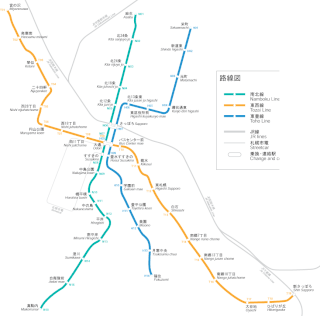
The Tokyo Metro is a major rapid transit system in Tokyo, Japan, operated by the Tokyo Metro Co. With an average daily ridership of 6.84 million passengers, the Tokyo Metro is the larger of the two subway operators in the city; the other being the Toei Subway, with 2.85 million average daily rides.

The Tokyo Metro Tozai Line is a rapid transit line in Tokyo and Chiba Prefecture, Japan, owned and operated by Tokyo Metro. Its name translates to "East-West Line". The line runs between Nakano in Nakano-ku, Tokyo and Nishi-Funabashi in Funabashi, Chiba Prefecture. The Tōzai Line was referred to as Line 5 during the planning stages; the seldom-used official name is Line 5 Tōzai Line. The line carries an average of 1,642,378 passengers daily (2017), making it the busiest line on the Tokyo Metro network. On maps, diagrams and signboards, the Tōzai Line is shown using the color "sky blue" and its stations are given numbers using the letter "T".

The Tokyo Metro Yurakucho Line is a subway line in Japan owned and operated by Tokyo Metro. The line connects Wakōshi Station in Wakō, Saitama and Shin-Kiba Station in Kōtō, Tokyo. On maps, diagrams and signboards, the line is shown using the color "gold", and its stations are given numbers using the letter "Y".

Sendai Station is a major junction railway station in Aoba-ku, Sendai, Miyagi, Japan. It is a stop for all Akita and Tohoku Shinkansen trains, the eastern terminus for the Senzan Line, and major stop on both the Tohoku Main Line and Senseki Line. It is located on the border between Miyagino and Aoba Wards in Sendai, Miyagi Prefecture.

The Sendai Subway Namboku Line is a rapid transit line of Sendai Subway in Sendai, Japan. It connects Izumi-Chūō Station in Izumi-ku, Sendai, with Tomizawa Station in Taihaku-ku, Sendai. The line is 14.8 km (9.2 mi) long and has 17 stations. Like many mainline trains and metros in Japan, it uses the 1067 mm track gauge and runs on 1,500 V overhead line. The name "Namboku" means south–north, which is the general direction that the track runs.

The Toei Mita Line is a subway line of the Tokyo Metropolitan Bureau of Transportation (Toei) network in Tokyo, Japan. The line runs between Nishi-Takashimadaira in Itabashi and Meguro in Shinagawa. Trains continue with direct service into the Meguro Line of Tokyu Corporation for Hiyoshi. The portion between Shirokane-Takanawa and Meguro is shared with the Tokyo Metro Namboku Line.

The Toei Shinjuku Line is a rapid transit line in Tokyo and Chiba Prefecture, Japan, operated by Tokyo Metropolitan Bureau of Transportation (Toei). The line runs between Motoyawata Station in Ichikawa, Chiba in the east and Shinjuku Station in the west. At Shinjuku, most trains continue as through services to Sasazuka Station on the Keiō New Line, with some services continuing to Hashimoto Station in Sagamihara, Kanagawa via the Keiō Line and the Keiō Sagamihara Line.
The Kinki Sharyo Co., Ltd. is a Japanese manufacturer of railroad vehicles based in Osaka. It is an affiliate company of Kintetsu Corporation. In business since 1920 as Tanaka Rolling Stock Works, and renamed The Kinki Sharyo Co., Ltd in 1945, they produce rolling stock for numerous transportation agencies, ranging from Shinkansen high-speed trains to light rail vehicles. Kinki Sharyo is listed on the Tokyo Stock Exchange as TYO: 7122.

The Osaka Metro Midōsuji Line is a rapid transit line in Osaka, Japan, operated by Osaka Metro. Constructed under Midōsuji, a major north-south street, it is the oldest line in the Osaka subway system and the second oldest in Japan, following the Tokyo Metro Ginza Line. Its official name is Rapid Electric Tramway Line No. 1 (高速電気軌道第1号線), while the Osaka Municipal Transportation Bureau refers to it as Osaka City Rapid Railway Line No. 1 (大阪市高速鉄道第1号線), and in MLIT publications it is referred to as Line No. 1 . On line maps, stations on the Midōsuji Line are indicated with the letter "M".

Sendai City Transportation Bureau is a public transport organization in Sendai, Japan. The organization operates subways and buses within the city. It was founded in 1926.

The Sendai Subway Tozai Line is one of the two lines of the Sendai Subway system operated by the Sendai City Transportation Bureau in the city of Sendai, Japan. It opened on 6 December 2015. The Tozai Line uses linear motor propulsion.

The Sapporo Municipal Subway is a mostly-underground rubber-tyred rapid transit system in Sapporo, Hokkaido, Japan. Operated by the Sapporo City Transportation Bureau, it is the only subway system on the island of Hokkaido.

The Sendai Subway 1000N series (仙台市交通局1000N系電車) is a rapid transit electric multiple unit (EMU) train type operated on the Sendai Subway Namboku Line in Sendai, Japan.

The Sendai Subway 2000 series (仙台市交通局2000系) is a Japanese rapid transit electric multiple unit (EMU) train type operated by Sendai City Transportation Bureau on the Sendai Subway Tōzai Line, which opened in December 2015.

Yagiyama Zoological Park Station is a subway station on the Sendai Subway Tōzai Line in Taihaku-ku, Sendai, Japan, operated by the municipal subway operator Sendai City Transportation Bureau. It is located near and named for the Sendai Yagiyama Zoological Park.

Aobayama Station is a subway station on the Sendai Subway Tōzai Line in Aoba-ku, Sendai, Japan, operated by the municipal subway operator Sendai City Transportation Bureau.

Omachi Nishi-koen Station is a subway station on the Sendai Subway Tōzai Line in Aoba-ku, Sendai, Japan, operated by the municipal subway operator Sendai City Transportation Bureau.

Aoba-dori Ichibancho Station is a subway station on the Sendai Subway Tōzai Line in Aoba-ku, Sendai, Japan, operated by the municipal subway operator Sendai City Transportation Bureau.

Miyagino-dori Station is a subway station on the Sendai Subway Tozai Line in Miyagino-ku, Sendai, Japan, operated by the municipal subway operator Sendai City Transportation Bureau.

Oroshimachi Station is a subway station on the Sendai Subway Tōzai Line in Wakabayashi-ku, Sendai, Japan, operated by the municipal subway operator Sendai City Transportation Bureau.




















